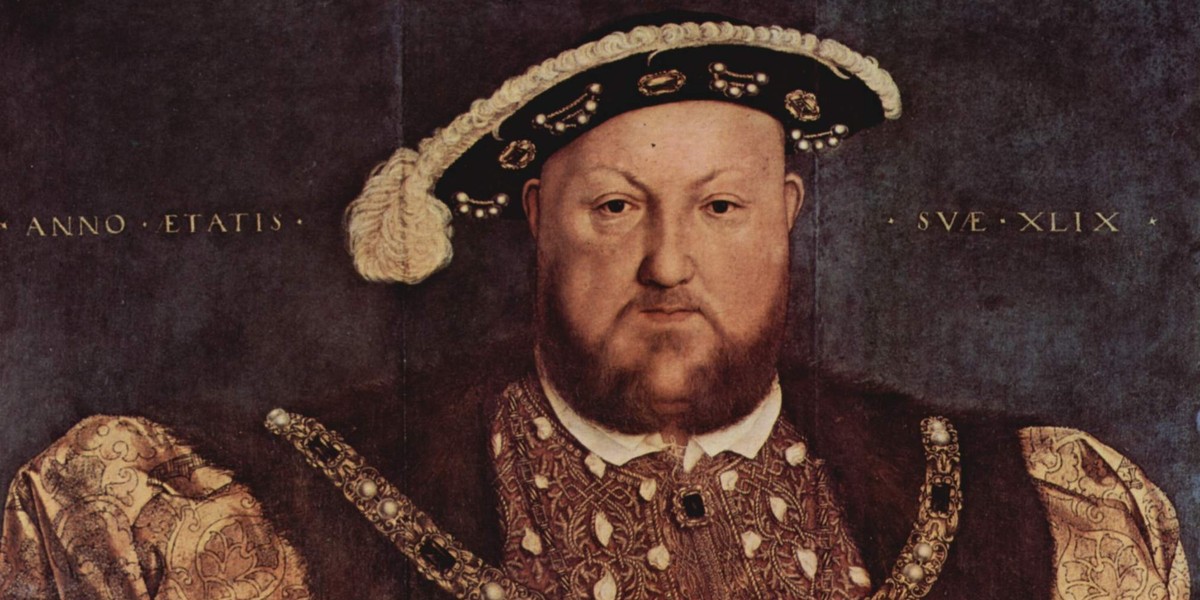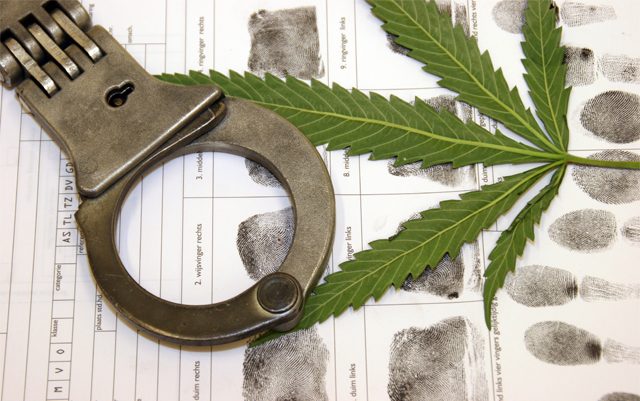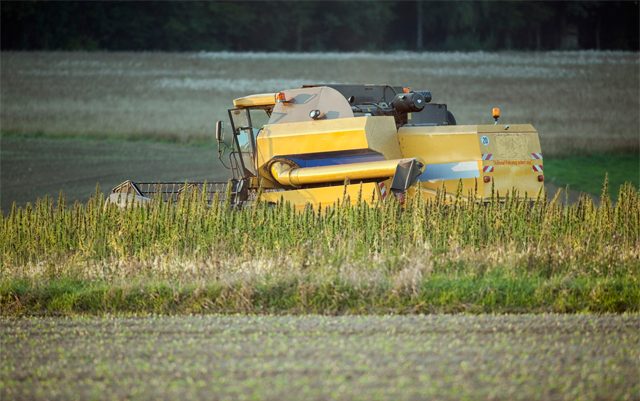Source:
farmandranchguide.com
 Clarence Laub, Jr., left, and his son, Clarence Laub III made history at their farm this spring by being one of the first farms in the state to plant industrial hemp south of Elgin, N.D., under the Department of Agriculture license.
Clarence Laub, Jr., left, and his son, Clarence Laub III made history at their farm this spring by being one of the first farms in the state to plant industrial hemp south of Elgin, N.D., under the Department of Agriculture license.
ELGIN, N.D. – Out in a field that can be viewed from the windows of a farmhouse in southwestern North Dakota, Clarence Laub III, finished seeding his industrial hemp crop on June 1.
Laub III had already planted the other crops on the family farm, planting their sunflowers the week before.
“We were able to get some early seeding done in early April because of the weather. The corn and the wheat are all up. The sunflowers are just emerging today,” Laub III said.
His industrial hemp crop is also coming up, but the emergence has been slow and spotty.
“We haven’t had a significant rain fall since the last week in May, and that could be part of the poor emergence,” he said. “I talked with another producer that was having the same slow emergence so I feel a little better about the situation now.”
So what was it like to plant industrial hemp and make North Dakota history? Was it somehow mysterious or different or something that the ordinary farmer would never attempt?
“It is an exciting experience, but it is a always a little flustering when trying a new crop for the first time,” he said. “However, being able to plant a new crop on a small scale makes it less stressful.”
Laub III noted he didn’t have a lot of time to think about how he was making history because the seed arrived from Canada late, and he had to hurry and seed it.
“I was too busy thinking of all the drill settings, making sure the depth was right. There’s not a whole lot of time to soak the whole process in,” he said.
Laub III is one of four farmers selected by the North Dakota Department of Agriculture to grow industrial hemp under its first-ever pilot program. The others are David H. Lommen of Maddock, N.D.; and Jamie Edwards and Lyle Edwards of Adrian, N.D.
Planting
Out in the field June 1, surrounded by fencing, his father Clarence Laub Jr., drove his John Deere tractor connected to his Concorde air drill with a Dutch opener and anhydrous ammonia tank – putting in row after row of industrial hemp seed.
The air drill had two compartments, one with seed and the other with starter fertilizer, 9-42-9-4.
He planted his seed into sandy-loam soil, at a rate of 30 and 35 pounds per acre, with the seed being placed into the furrow at two depths. Seed was placed in furrow at a depth of one-half to three-fourths of an inch, fairly shallow, while other seed was placed at a depth of one-and-a-quarter inch.
“This was a totally new process for our drill but it went smoothly,” Laub, Jr., said. “Getting the depth right was the biggest problem I had.”
Laub, Jr., planted one variety; then seeded the other. When he was finished, he measured off the field and marked the center.
At the NDSU Langdon Research Extension Center’s hemp plots last summer, there was a high seed mortality rate, and it was recommended that the soils be warm before planting.
Farming background
Before returning to farm full-time, Laub III attended Bismarck State College, gaining a degree in agronomy and worked in Elgin as a sales agronomist for Wilbur Ellis, so he knows his seed. He also interned with New Horizons Ag during summers at college. As an intern, he worked closely with producers as a crop consultant, scouting their fields and helping them plan which herbicides, fungicides and insecticides to use.
While he has all that information on board, he won’t be able to use any chemicals on his industrial hemp fields. Not because he is going organic, but because there are no herbicides or other chemicals labeled for use in North Dakota.
That could make the crop a bit weedy, but he is hoping as it grows, the green canopy will crowd out the weeds. In addition, the field where the industrial hemp is planted, had a solid burndown following harvest last fall.
“It’s a pretty clean field, but any weeds that might pop up should be crowded out as hemp grows,” Laub III said.
In fact, at LREC, most of the varieties grown last summer grew a couple of inches a day, so did provide heavy canopy.
Laub III has researched extensively the best ways of planting, growing and harvesting industrial hemp. Canada has conducted considerable research into industrial hemp, and North Dakota farmers growing hemp now have some good information available to help them.
“I talked with a fellow farmer who is growing industrial hemp in Colorado, and he helped me with choosing one of the varieties I am growing this summer,” said Laub III, noting he eventually settled on the Canadian varieties, CFX-1 and CRS-1. “These varieties both have strengths and I think they are the right varieties for our farm and for what I intend to market them for.”
The four producers in the pilot program are allowed to market the hemp anyway they like.
CFX-1 is a dual-purpose variety, that can be used for both fiber and grain, and CRS-1 is a grain variety, that is often crushed and used for oil. He plans to purchase a cold oil extractor to extract the oil from the industrial hemp, bringing it right to the farm field, instead of hauling it a long distance.
Last year, harvest at LREC, CFX-1 yielded 4,648 pounds per acre of fiber and 1,363 pounds per acre of grain. CRS-1 yielded 1,062 pounds per acre of grain.
Laub III plans to harvest his grain with his twin-rotor New Holland with a draper head. While some industrial hemp fiber varieties are very tall, he chose two of the shorter varieties, so the plants would be easier to harvest.
Laub III farms with his parents, Clarence Laub Jr., and Sandra. Laub Jr., bought the family farm in 1977.
Laub III said his mom was the one who encouraged him to grow industrial hemp back in 2008, when the first two North Dakota farmers were issued licenses to grow it at the state level.
A year ago, he was talking with Rachel Seifert-Spilde at the North Dakota Department of Ag, and she mentioned the pilot program to him. The Farm Bill had passed an industrial hemp law, and states like Colorado and Kentucky were already at the stage of having their farmers grow hemp on their own farms under the license of the particular state.
Laub III began researching how he would grow, harvest and market it.
“I was very excited and wanted to make the application perfect,” he said.
Obviously, the application was sufficient and the Department announced that Laub III would be one of the first four farmers in the pilot program.
“I knew I had a good application, but you never know,” he said.
A unique farm
The farm is unique, having the look of the very new, blended with the old.
The farmhouse, which towers over all the other buildings, and the new red barn next to it are fairly new, built in 2011.
“Sandra always wanted a large house, but she didn’t expect to have it the way it happened. We had a tornado in 2011 that destroyed a lot of the farm buildings, and I told her, ‘the new house is yours – do it how you want,’” said Laub Jr.
The tornado came out of nowhere, right after they had finished seeding their acres. Everyone was in the house at the time.
“It happened so fast. We heard the tornado – it sounded like a roaring train and we headed downstairs. At the same time, the barn blew into the side of the house,” Laub Jr., said.
Because they had just planted, the new seeds hadn’t come out of the ground yet, Laub III added. They had a good crop that year – but after the tornado, it was an expensive crop.
That is part of the reason Laub III wanted to grow industrial hemp. Out in southwestern North Dakota, moisture can be limited, so he was interested in an alternative crop that would be a good rotational crop for farmers, one that would help break up weed and disease cycles, provide another choice for farmers in the region, and improve the economic bottomline.
Laub III points to all the hemp related products North Dakotans can buy at stores, including insulation, warm clothing that is long-lasting, or even a hemp concrete called hempcrete, that is known to be very strong.
“We import all these hemp products in and finally, we can start to supply those products ourselves,” he added. “Industrial hemp should be a great rotational crop and we need that in southwestern North Dakota.”
He is definitely looking forward to watching his industrial hemp seeds grow and then, eventually, harvesting the crop before marketing his new crop – one he hopes will provide benefits both for his rotations and bottom line as well.
Clarence Laub, Jr., left, and his son, Clarence Laub III made history at their farm this spring by being one of the first farms in the state to plant industrial hemp south of Elgin, N.D., under the Department of Agriculture license.

 Diego Velázquez - Philip III on Horsebackwikipedia.org
Diego Velázquez - Philip III on Horsebackwikipedia.org



